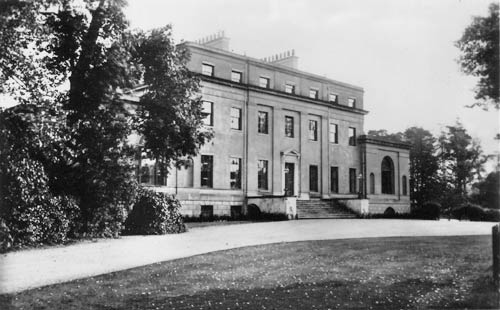Wilton Park
Berkshire
| Location | nr Beaconsfield | ||
| Year demolished | 1968 | ||
| Reason | Replaced by Army accommodation block | ||
| See all images: | Gallery | ||
| << Back to the main list |
Few houses can claim to have had such a dramatic change in their pace of life than Wilton Park in Buckinghamshire.
 Wilton Park was built in 1779 by Josais Du Pre, a former Governor of Madras in India. Known as the 'White House' because of its striking plastered exterior, it was a fine Georgian Palladian mansion seven bays wide by three floors high. The east front was decorated with four giant pilasters rising to the top of the first floor and had a wide entrance staircase leading to the front door which was surmounted by a shallow pediment. The west front faced the parkland and had a full height central canted bay in front of which was a wide terrace with steps leading down to the lawn. The interiors were by Robert Adam. It survived with almost no structural or major interior changes for over 160 years which can no doubt be partly due to its ownership by a single family - the Du Pre's. The house had passed down through the generations quietly sitting just outside Beaconsfield in beautiful parkland.
Wilton Park was built in 1779 by Josais Du Pre, a former Governor of Madras in India. Known as the 'White House' because of its striking plastered exterior, it was a fine Georgian Palladian mansion seven bays wide by three floors high. The east front was decorated with four giant pilasters rising to the top of the first floor and had a wide entrance staircase leading to the front door which was surmounted by a shallow pediment. The west front faced the parkland and had a full height central canted bay in front of which was a wide terrace with steps leading down to the lawn. The interiors were by Robert Adam. It survived with almost no structural or major interior changes for over 160 years which can no doubt be partly due to its ownership by a single family - the Du Pre's. The house had passed down through the generations quietly sitting just outside Beaconsfield in beautiful parkland.
However, the Second World War was to radically change all this. It was leased to the War Office in 1939 and became a top secret interrogation centre for senior Nazi prisoners of war. The camp was known as the Combined Services Detailed Interrogation Centre (CSDIC) with the house becoming an officer's mess for the senior staff and interrogators. The parkland proved an ideal site to built the Nissan huts used to house the other staff and the brick and concrete compound for the prisoners. The work started in July 1942 and the first prisoners arrived a year later. Famous 'visitors' included Marshall Messe, Field-Marshalls von Rundstedt and Busch and Rudolph Hess.
Following the end of the war the CSDIC closed down and the house passed to the Foreign Office who ran programmes to 'de-Nazi' Germans and to help establish a democratic Germany. Between 1946-48 over 4,000 Germans came to Wilton Park to discuss these ideals with leading British intellectuals and political figures. This process has been credited with ensuring that the political mistakes of the Treaty of Versailles at the end of World War I, which created the conditions which facilitated the rise of the Nazis, were not repeated following the end of World War II.
The Foriegn Office had to share the estate with the Army School of Administration which moved in during 1949 with the Army School of Education also joining them in April 1950. Possibly feeling rather crowded the Foreign Office moved to Wiston House in West Sussex - though they retained the name Wilton Park and continued to host conferences, providing a forum for "leading opinion formers to discuss the best ways to deal with key challenges".
The Army proceed to build, re-build and extended their buildings including the construction of a nuclear bunker strangely attached to the old kitchen garden (scroll down to the bottom - the garden wall is still visible). During the 1960s three Forces language schools (now the Defence School of Languages) were also established at the site. This new pressure for space and the increased number of people meant that the 'White House' was demolished in 1968 to be replaced by the tallest building in Buckinghamshire - an ugly 15-storey accomodation block.